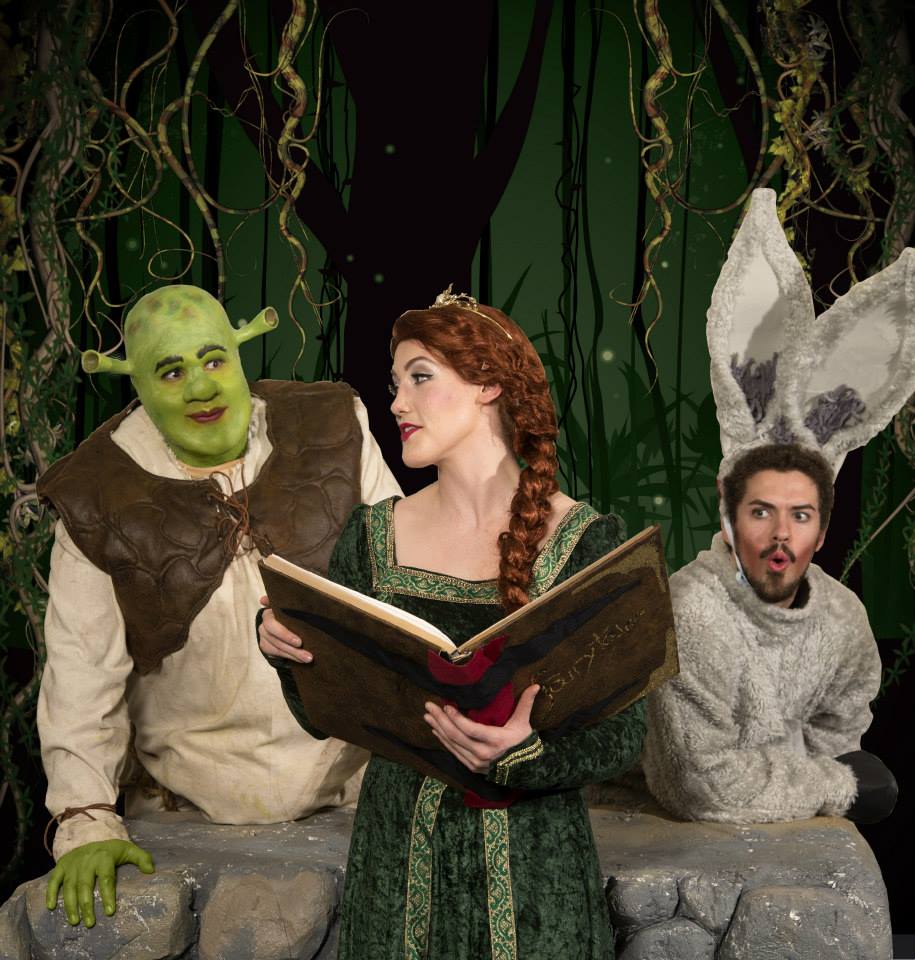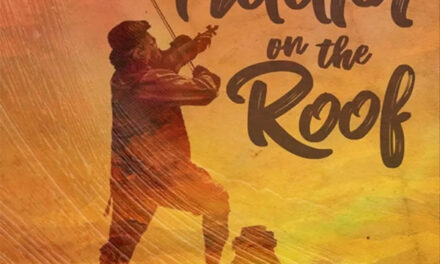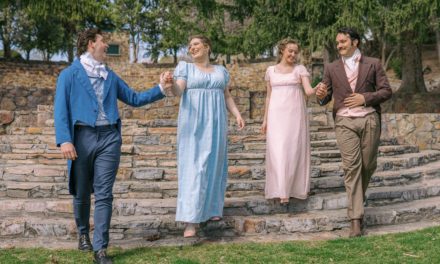OREM — There’s a new ogre in town. He’s tall, gruff, cranky, and very green, as all self-respecting ogres are known to be. But if one looks a little deeper, down through his more carefully hidden layers, his lesser known qualities may also include a penchant for campfire delicacies, a soft spot for talkative donkeys, and a pining for the “happily-ever-after” he was taught never to expect. Shrek, the popular ogre with a Scottish brogue, made famous by DreamWorks animated films, has landed on a Utah stage along with his sidekick Donkey and his secret crush Princess Fiona. Add in a diminutive wanna-be King Farquaad and a slew of fairy tale creatures to the mix, and the result is a charming production well-suited for family theatre-goers.
Director Chase Ramsey stuck closely to the fairy tale theme by implementing “book” references and analogies throughout the production. From the opening scene, shown through the title page of a book reading “Once upon a time,” to Pinocchio (Marshall Madsen) announcing the number and title of each chapter as the story progressed (It was a good idea on paper, but got a little annoying by the end.), to the finale wherein each character in the show ends up reading his/her own “storybook,” the theme was very evident. The characters are in fairy tale land, and everything that the audience sees on stage is a fairy tale. But overall, it worked just fine, and my children (and others in the audience, if the positive reactions are anything to go by) were thrilled to be “reading” this particular story.
Shrek, played by B.J. Oldroyd, starts out our story explaining how he got to be a grouchy old ogre. Getting kicked out by your parents when you were a wee ogre of just seven-years old will do that to you, right? After getting Shrek’s background, Fiona (Madeline Weinberger) pops on the scene to introduce herself, and the story is underway. The plot should be familiar to anyone who has seen the movie: the Fairytale creatures of Duloc have been rounded up by order of Lord Farquaad (Carson Davies), a halfling would-be-king who is obsessed with cookie cutter uniformity and color coordination. Anyone who doesn’t meet his standards for dress and appearance is not allowed within eyesight of his precious would-be-kingdom Duloc. The more unusual characters such as Pinocchio, the Sugar Plum Fairy (Shelley Young), the White Rabbit (Cody Whitlock) and many others are banished to a swamp—Shrek’s swamp to be precise. This sets a chain of events in motion which will change his life (and the creatures’) forever. In order to retain sole ownership of his swamp, Shrek takes on a quest for Lord Farquaad, namely to rescue Princess Fiona from her dragon-guarded keep and bring her back, so that Farquaad can marry a real princess and thereby become a true king. Along the way Shrek unwillingly picks up a traveling companion aptly named Donkey (Wes Tolman) whom he can’t shake, and all the players are on board for a fairytale adventure.
Of the four main characters, Weinberger as Fiona gave the strongest performance, with her very expressive face and impressive vocal chops. I loved that Wienberger didn’t simply try to copy Sutton Foster’s portrayal of the original Broadway Fiona, but rather created her own interpretation of a princess who had been kept in solitary confinement for 20 years. Weinberger’s Fiona was quirky, funny, endearing, and—most of all—believable as a girl who would fall in love with the ogre most people would shun at first sight. Most of the other actors seemed to stick more closely to the original Broadway and movie characterizations, though. Perhaps they could be forgiven, because the story and main characters have become so iconic over the years.
Oldroyd as Shrek was solid and winsome. His relationship with Fiona had a nice arc to it; I could see the subtle evolution he made from a gruff and judgmental outcast hired to do a job, to a creature scared of the rejection he always known, but daring to put his heart on the line. With great vocal ability and a decent accent to boot, Oldroyd’s was a solid performance. And Oldroyd’s poignant solo “When Words Fail” was very effective in conveying the emotions of David Lindsay-Abaire‘s lyrics and Jeanine Tesori‘s music. The relationship between Shrek and Donkey was also nicely developed, although many of their important interactions felt a little rushed. Donkey is an impetus that forces Shrek to rethink his perceptions of the world and conversely how the world sees him. The moments often felt glossed over when they could have been mined for more poignancy. But Tolman’s Donkey songs were entertaining and fun, partially because Tolman is an accomplished vocalist. The strongest of the show was the only one sung by Tolman, Oldroyd, and Weinberger, “Who I’d Be.” It started out with Shrek fantasizing about another possible life if he weren’t an ogre, with Fiona and Donkey joining in at the end. Their voices blended beautifully together, I could hear each distinct melody and felt their strong connection at that moment.
Carson Davies was a good choice for Lord Farquaad, with just the right amount of nasal whine and petulance to make me hate him. He navigated an early wardrobe malfunction very well, and his dance numbers were well executed. Although there aren’t many huge dance numbers, the choreography by Geoff Reynolds was clever and fun. “Let Your Freak Flag Wave” performed by all the fairy tale creatures was the best dance number in the show. “I Got You Beat” was grossly funny and provided an important turning point in Shrek and Fiona’s relationship. In general the blocking was simple and functional, although I was frustrated by the tendency for all actors to stand in full profile to the audience, which makes for a lot of backsides on stage unless an audience member sits dead center in the house.
The set design by Steve Purdy used various levels and moveable stair and wagon units to indicate different areas of the endless forest through which the characters wander. But ultimately, it’s still a lot of wandering through a lot of forest. The use of different configurations of blocks and stairs might have worked better, but I was distracted by the appearance of random guards and fairytale creatures and villagers to move the set pieces in the middle of scenes with only Shrek, Donkey, and Fiona. Also, the sightlines were an issue for much of the performance. From where I was sitting in the left side of the house, we could see straight back into the backstage area, where actors and stage crew were hanging out, changing costumes, and chatting while waiting to make an entrance. My children were often more fascinated by what was going on backstage than what was happening onstage.
Costumes designed by Deborah Bowman and Kelsey Seaver had definite highs and lows. Again, Shrek and Fiona and Donkey and Farquaad looked exactly I expected them to look after having seen the film. The fairy tale creatures were cute, colorful and easily identifiable, as were the guards and other minor characters. The problem arose because the entire ensemble played multiple roles, which I’m sure was fun for the actors, but apparently didn’t leave much time for costume changes. The Duloc Dancers, for example, were clearly all the same Fairytale Creatures, with their Duloc costumes pinned on top of their fairytale costumes. Skirts, shirts, pants, and weird shoes hanging out the bottom of the bright shiny red and blue uniforms were just distracting and confusing.
The technical aspects, upon which so much of this story relies, with dragons, transformations, and more, were unfortunately somewhat lacking. Very simple lighting effects stunted what could have been a great moment when Fiona transforms, and the dragon was not as imposing or scary as she could have been, although Lauren Anderson as the voice of the Dragon knocked the number “Forever” out of the park.
But ultimately, the appeal of Shrek the Musical is encapsulated in the final number of the show, when everyone onstage sings “This is Our Story.” The message is clear, and it’s a good one: We are all unique, we are all worthwhile, our dreams are valid, and it’s our differences that make us strong. Own it. Love it. Make it your own. And that’s a great message for anyone to leave the theater humming about.










